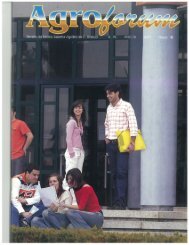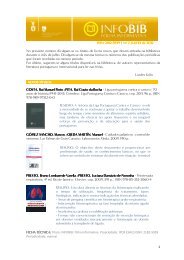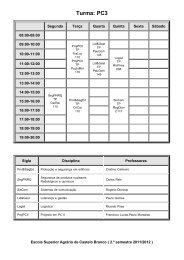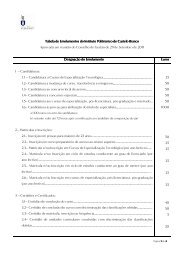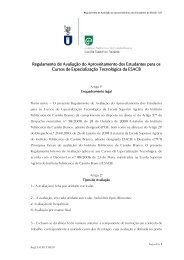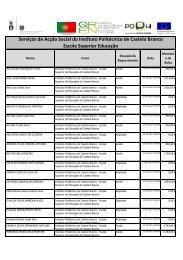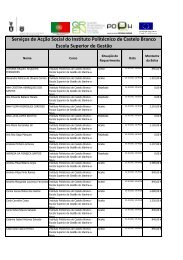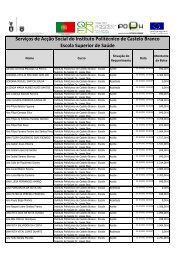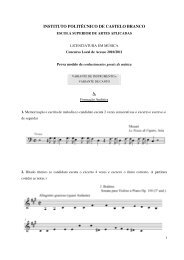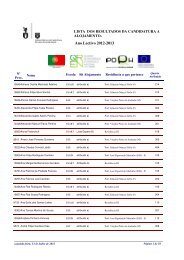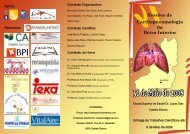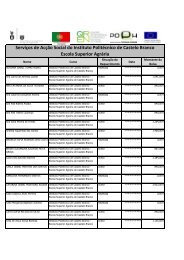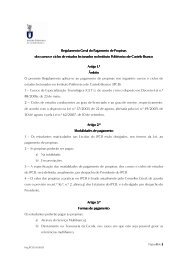N.º 24 - PDF - Instituto Politécnico de Castelo Branco
N.º 24 - PDF - Instituto Politécnico de Castelo Branco
N.º 24 - PDF - Instituto Politécnico de Castelo Branco
Create successful ePaper yourself
Turn your PDF publications into a flip-book with our unique Google optimized e-Paper software.
Research is greatly nee<strong>de</strong>d to improve the agronomy<br />
of cultivated MAPs, promote the exchange of information<br />
on agricultural production and investigate the social<br />
and environmental impact of MAP cultivation and<br />
collection.<br />
CONCLUSION<br />
Figure 2 – Storage in a great store<br />
Reusable packaging material such as jute sacks and<br />
mesh bags should be well cleaned (disinfected) and thoroughly<br />
dried prior to reuse. All packaging materials should<br />
be stored in a clean and dry place that is free from pests<br />
and inaccessible to livestock, domestic animals and other<br />
sources of contamination. A label affixed to the packaging<br />
should clearly indicate the scientific name , the plant part,<br />
the place of origin, the cultivation or collection date and<br />
the name of the grower/collector and the processor and<br />
quantitative information.<br />
Whenever required and when is possible, fresh MAP materials<br />
should be stored at appropriate low temperatures, i<strong>de</strong>ally at<br />
2-8ºC; frozen products should be stored at less than –20ºC.<br />
9. Threatened and endangered<br />
species<br />
MAPs that are protected by national and international<br />
laws, such as those in national “red” lists, may be collected<br />
only by relevant permission according to national and/<br />
or international laws. The provisions of the Convention on<br />
International tra<strong>de</strong> in Endangered Species of Wild Fauna<br />
and Flora (CITES) must be complied with.<br />
When medicinal plant materials from threatened, endangered<br />
or protected medicinal plant species are obtained<br />
through cultivation, they should be accompanied by appropriate<br />
documentation in accordance with national and/ or<br />
regional regulamentation.<br />
10. Research needs<br />
The very strong expansion of the MAP sector is, above<br />
all, based on changes in life-style in the industrial countries.<br />
The perfumery and the cosmetics industries have respon<strong>de</strong>d<br />
to the success of health products, whereas flavour have<br />
became essential to more sophisticated food products.<br />
They are multiple the references of use of the aromatic<br />
ones in gastronomy, medicine and cosmetics<br />
The intensity of its flavour, the wealth in vitamins, antioxidants<br />
and minerals makes these plants contribute for a<br />
healthier life.<br />
Intense flavour allows to reduce the amount of other<br />
harmful seasonings to the health *ex:SALT.<br />
Relationships between synthetic and natural materials<br />
are the key point for the future trends in the market<br />
of essential oils, <strong>de</strong>pending on scientific and technological<br />
progress.<br />
Up to 1930 natural products dominated the scene, and<br />
the expertise at Grasse was <strong>de</strong>cisive in <strong>de</strong>termining approaches<br />
to production, extraction and blending. Developments<br />
in synthesis were relatively slow: the first step<br />
was to isolate natural molecules (cinnamal<strong>de</strong>hy<strong>de</strong> for<br />
cinnamon and benzal<strong>de</strong>hy<strong>de</strong> from bitter almonds). The<br />
first synthetic flavour appeared in 1850(amyl acetate)<br />
and 1876 (vanillin). The mo<strong>de</strong>rn perfumery uses sophisticated<br />
synthetic molecules and numerous molecules protected<br />
by patent have taken place of traditional oils. They<br />
are still used in the most famous perfumes formulated<br />
<strong>de</strong>ca<strong>de</strong>s ago, but they are progressively abandoned in the<br />
new formula.<br />
The market and the industrial use of aromatic plants<br />
is very contrasted, with short circuit of commercialization<br />
and products which have un<strong>de</strong>rgone minimum transformation.<br />
Each market sector will have particular consequences<br />
on the production sector. In or<strong>de</strong>r to be competitive, a producer<br />
must make a precise i<strong>de</strong>ntification of the market requirements,<br />
the strategies of the international tra<strong>de</strong>rs, the<br />
price <strong>de</strong>termination and the production capacities of the<br />
existing producers.<br />
It is important to <strong>de</strong>termine the most profitable market<br />
sector, and to <strong>de</strong>termine the key factor in competitive production<br />
for each of these market branches.<br />
For the aromatic plant market, we can distinguish in<br />
particular:<br />
n.º <strong>24</strong> Ano 18, 2010 9



